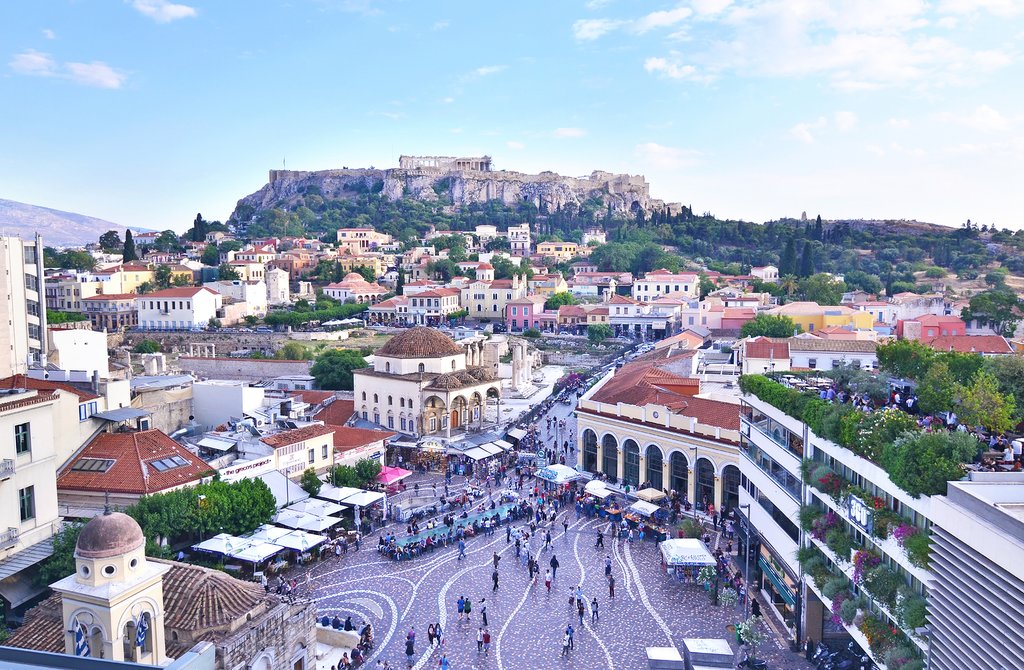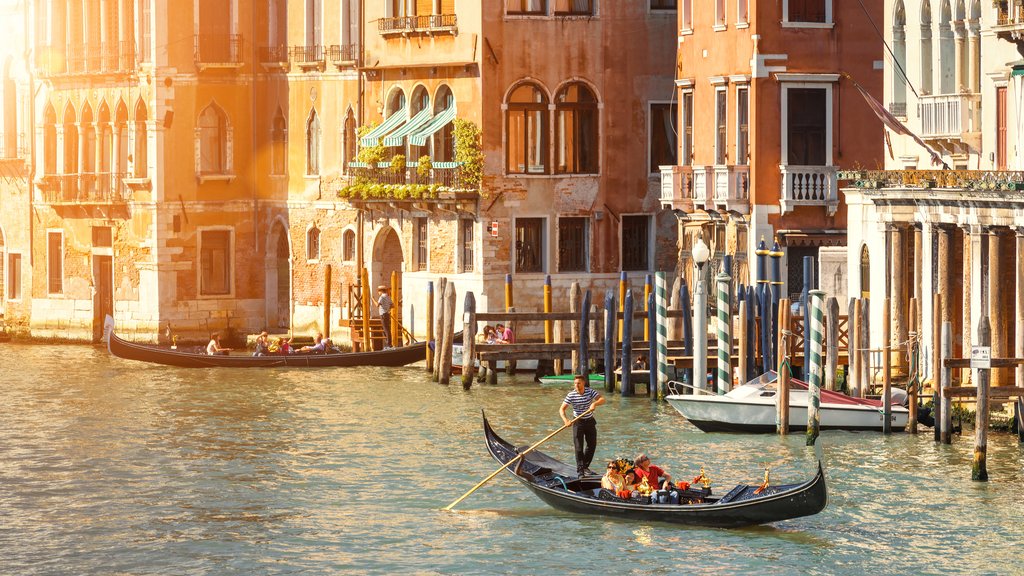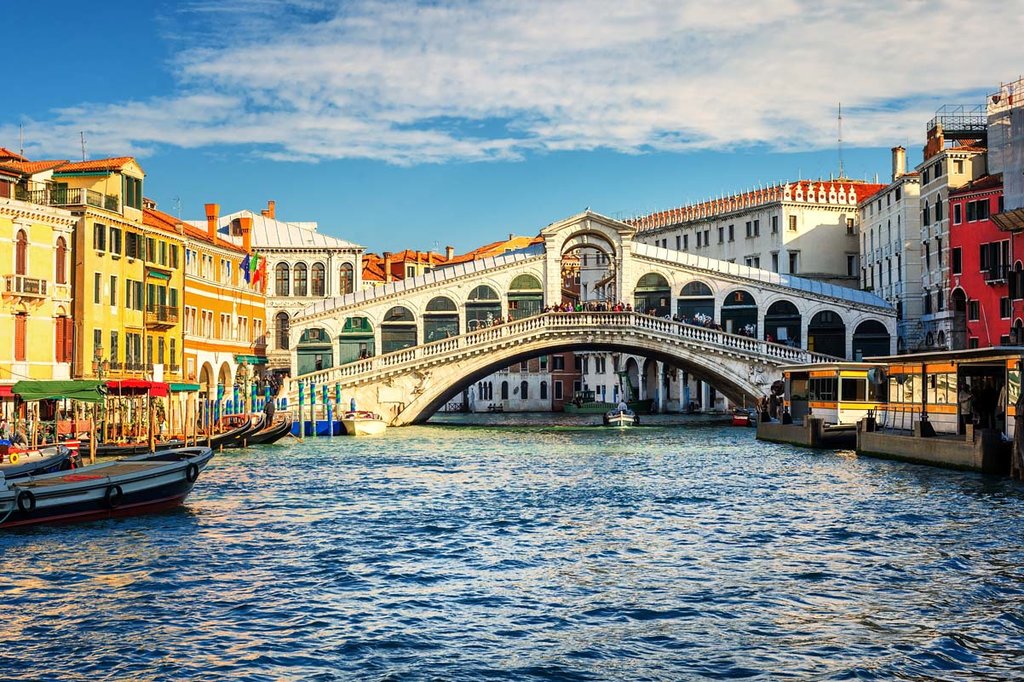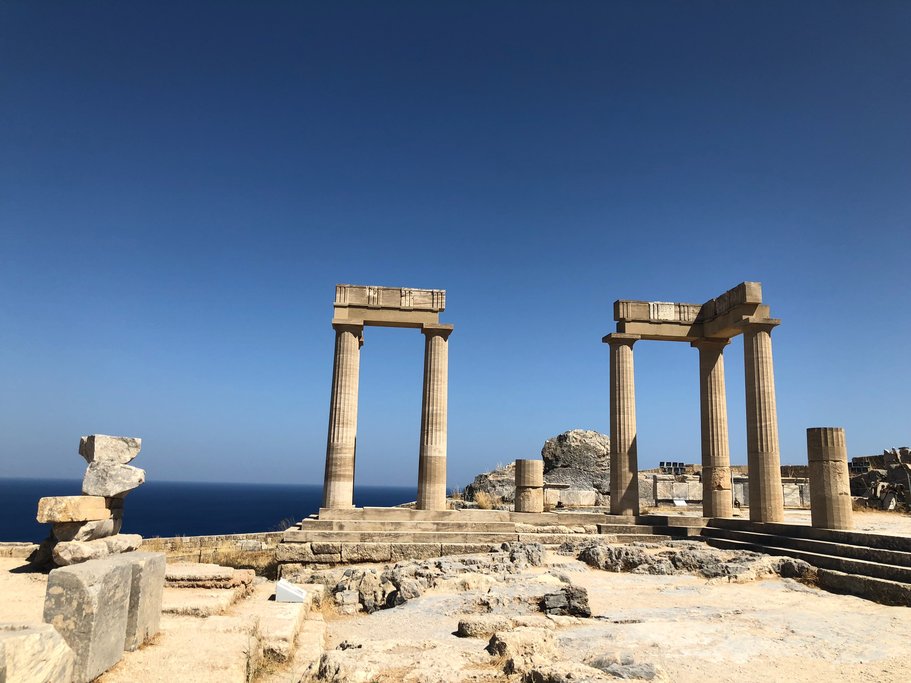Highlights
- Tour the 3,500-year-old Minoan Palace of Knossos
- Explore the sprawling archaeological site at Delphi
- Immerse yourself in the history of Rome & Athens, two ancient capitals
- Get special access to secret rooms in the Doge's Palace
- Visit the incredible ruins of Pompeii, preserved by Mt. Vesuvius’ eruption
Brief Itinerary
| Day | Highlights | Overnight |
|---|---|---|
| Day 1 | Arrive in Athens | Athens |
| Day 2 | Day Trip to Delphi | Athens |
| Day 3 | Mycenae, Nafplio, and Epidaurus Day Trip | Athens |
| Day 4 | Guided Acropolis Visit & Flight to Crete | Heraklion |
| Day 5 | Explore Knossos and Heraklion | Heraklion |
| Day 6 | Heraklion to Rhodes & Medieval Tour | Rhodes |
| Day 7 | Ancient Cities of Rhodes Tour | Rhodes |
| Day 8 | Flight from Rhodes to Venice & Gondola Tour | Venice |
| Day 9 | Historical Venice Walking Tour & Secret Passages | Venice |
| Day 10 | Venice to Rome & Guided City Tour | Rome |
| Day 11 | Colosseum & Ancient Rome Tour | Rome |
| Day 12 | From Rome to Naples | Naples |
| Day 13 | Pompeii and Mount Vesuvius | Naples |
| Day 14 | Depart Naples |
Detailed Itinerary
Day 1: Arrive in Athens

Welcome to Greece! You'll begin your trip in Athens, home to the iconic Acropolis and so much more. The mythology of this spectacular city precedes it, with towering temples and the ruins of ancient marketplaces rubbing shoulders with lively nightlife, crowded flea markets, and contemporary cuisine. Make the most of your time in the city at some of these spots:
- Check out the views of the can't-miss Parthenon. (Pro tip: The Parthenon is the temple, the Acropolis is the hill.) This temple to Athena has enchanted visitors since its construction was completed in 438 BCE. It's probably the first thing that comes to mind when you think of ancient Greece and is visible from many of the city's high points.
- Stop at the sprawling National Museum for a crash course in ancient iconography. Be sure to seek out the room housing the Antikythera mechanism, essentially an ancient astronomical computer.
- Visit a smaller archaeological site at the Tower of the Winds, then stroll down neighboring pedestrian Aiolou Street to stop at shops and cafes.
- Find your perfect souvenir or sun hat in the busy stalls of the Monastiraki flea market.
- Spend your evening exploring the up-and-coming Pangrati neighborhood or amid the nightlife and mezze of the Psyrri district.
Day 2: Day Trip to Delphi

Today, you'll seek out the oracle during a day trip to the ruins of Delphi, once home to priestesses of Apollo who Ancient Greeks believed could predict the future. After being transferred from your hotel to Delphi (about 2.5 hours from the city), you'll take a guided tour through this sprawling archaeological site, with stops such as the Treasury of the Athenians, the Temple of Apollo, and expansive theater.
Explore the ruins or venture up an ancient footpath once used by worshippers of the god Pan, who started from the temples of Delphi and proceeded to Corycean Grotto for their religious rites, surrounded by the valley of olive trees and views of the Corinthian Gulf and peaks of the Peloponnese on your way.
Outside of the ruins, you'll head to an old section of town that used to serve as the leather tanner's district. One of Greece's last bellmakers keeps his workshop here; if you're lucky, he may be on-site for a visit. Lunch will be served under the plane trees in the town square, with cheeses, Amfissa olives, and traditional home cooking.
Head indoors after lunch to the museum, a short downhill walk away. Wander through its halls to find the bronze Charioteer of Delphi, marble Sphinx of Naxos, and what may be the first recorded notation of a melody once inscribed on the walls of the Athenian Treasury.
You'll be transferred back to Athens in the late afternoon to rest up or spend the evening out and about in the city.
Day 3: Mycenae, Nafplio, and Epidaurus Day Trip

Don't skip breakfast, as you're in for a full day with this private guided tour. Your first stop is the Corinth Canal, connecting the Ionian and Aegean seas.
You may recognize your next destination of Mycenae from its role in Homer's Iliad: It was home to the famous Helen, whose Mycenean husband King Agamemnon led his people to war when she left him for Paris of Troy. See its Cyclopean walls, which got their name due in part to the belief that only the mythical Cyclops would have been strong enough to lift their boulders. Pass through the Lion's Gate to enter the ruins of the city, wandering past the tombs of Aegisthus and Clytaemnestra and the Treasury of Atreus.
Your next stop is Nafplio, one of the prettiest seaport towns in the Peloponnese peninsula and once believed to have been founded by the son of Poseidon. The town was the first capital of the new Greek state after the war of independence in the 1800s. Take a stroll through the old town, where you'll pass statues honoring significant figures from Nafplio's history, Ottoman fountains, and Venetian architecture along the winding streets, topped off by the Bourtzi Castle in the middle of the harbor. Then drive up to see the view from the Palamidi Castle high above the town.
After lunch in Nafplio, you'll stop in the small ancient city of Epidaurus, one of the most visited healing centers in the world during its peak. The sick would travel here to visit the Sanctuary of Asklepios, the god of medicine and healing, and spend the night in the temple's sleeping hall in hopes that the deity would appear in their dreams with a diagnosis and cure for their condition. You'll also see the city's third-century theater, one of the best remaining examples of its type due to the excellent acoustics and aesthetic arrangement.
Return to Athens and your lodgings in the evening.
Day 4: Guided Acropolis Visit & Flight to Crete

Today you'll get to experience the mighty Acropolis — ruins of the iconic 5th-century BCE complex located on the rocky hilltop overlooking the city. Take a private guided tour of the entire area with a professional guide who will share the stories of the country's most famous monument. In addition to the iconic Parthenon, dedicated to the city's patron goddess Athena, you'll view and learn about the Propylaea, the Temple of Athena Nike, and the most sacred temple of Erechtheion. Your guide will also provide you with an iPad, which you can use to view the augmented reality displays of the building's original splendor in 3D.
Complement your tour with a trip to the nearby modern Acropolis Museum. Many of the more delicate statues and other artifacts originally found at the Acropolis have been moved here, but you can imagine them in their previous home as you explore the exhibits. Complete your visit with a stop in its cafe for either lunch or a relaxed snack and coffee.
After lunch, head to the historic neighborhood of Plaka, to wander down its many cobbled streets and enjoy refreshments at a local cafe. Then, transfer to the airport to catch your flight to Heraklion, the capital of Crete.
Day 5: Explore Knossos and Heraklion

After breakfast, you'll set off to explore the magnificent Palace of Knossos. This 3,500-year-old Minoan palace is a sprawling maze of royal chambers, grand staircases, storerooms, and workshops. The evocative Bronze Age site is believed to be Europe's oldest city; it flourished for nearly 2,000 years as an economic center, trading with cities across the Mediterranean.
Follow it up with a guided afternoon tour. Stroll through the streets of Heraklion, starting with the Archaeological Museum, home to one of the largest collections of Minoan artifacts in the world. Continue around the old city's medieval streets, with architecture representing the island's Venetian past. Highlights include the elegant arches of the Loggia, now in use as the town hall, and the Koules Venetian fortress along the harbor walls.
A pleasant pedestrian street in the Old Town connects the port area with the Lions' Square and its Venetian fountain. Don't miss "mama's food" at Anchorage Traditional Mezedopolio nearby.
Chat with a local specialist who can help organize your trip.
Day 6: Heraklion to Rhodes & Medieval Tour

Depart for Rhodes, the largest of the Dodecanese islands, after your breakfast. The UNESCO World Heritage-designated Old Town of Rhodes hosts a complete medieval city and highly preserved castle. The Old Town was constructed mainly between 1309 and 1522 when the island was occupied by the Knights of St. John.
Your guide will take you through the streets and their history, including the city's role as the gateway to the Aegean Sea and its trade routes, the construction of the defensive walls and the sieges and earthquakes they've withstood, and the Byzantine fortress at the highest part of town. You'll stop at the Palace of the Grand Master of the Knights and medieval clock tower as you make your way through the 11 gates and numerous bastions and towers.
If you spend your evening on the seafront later, don't forget to stop at the point where the Colossus of Rhodes, one of the Seven Wonders of the Ancient World, once stood.
Day 7: Ancient Cities of Rhodes Tour

During today's explorations, your guide will take you through a trio of ancient city-states, once listed by the poet Homer as the three city-states founded by the Dorians.
You'll start in the fishing village of Lindos, known for its hilltop acropolis. The site was home to a temple to Athena in 300 BCE and was one of the island's major Greek and Phoenician trading centers during the Classical era. The temple was later partially incorporated into the 14th-century fortress built by the Knights of St. John to defend the region against the Ottomans. Stop at the Bay of St. Paul, or any of the other coves along the coast, on your way out to take in the Aegean sea views.
Your next stop is the three-level city of Kameiros. The two lower levels are considered one of the best remaining examples of an ancient Greek neighborhood, while the top level was home to the acropolis. Detour to the Valley of the Butterflies, a quiet river grove and park that in the summer is home to the lifecycle of millions of butterflies.
The last stop before your return to Rhodes Town is Ialyssos, home to a range of archaeological findings. Explore the Mycenean tombs, a lion-headed Doric fountain, and a temple to Zeus and Athena Polias alongside more recent additions from the Knights of St. John.
Day 8: Flight from Rhodes to Venice & Gondola Tour

Welcome to Italy! Arrive in Venice Airport, then transfer to the city center to your hotel. Settle in and spend the rest of the afternoon exploring the city on your own.
Venice in northern Italy is famous for both industry and tourism. With nicknames like "Queen of the Adriatic", "City of Water", and "The Floating City", it's clear that the city's myriad canals are its main draw. Stretching across 117 small islands in the marshy Venetian Lagoon along the Adriatic Sea, the city has long been a commercial and cultural hub thanks to its strategic placement. Silk, grains, spices, and art were traded through the Middle Ages, making Venice very wealthy.
The city is also famous for its many beautiful historic attractions, such as the Piazza San Marco and San Marco Basilica, the Grand Canal, and the ornate Doge's Palace. The Lido de Venezia is a popular luxury destination that attracts actors, critics, and other cinema industry celebrities.
There's something to be said for the classics. When in Rome, do as the Romans do, and when in Venice, take a gondola tour of its romantic canals. This is the classic ride — a leisurely 30-minute jaunt along Venice's waterways under the power and guidance of a professional gondolier.
It may be a popular tourist activity, but gondolas have been used as transport in the City of Water for well over 1,000 years. This elegant and romantic mode of transport will leave you perfectly content as you leisurely glide on the surface of the water, under Rialto Bridge, and as you pass iconic landmarks like Rialto Square.
After your 30 minutes on the water, you'll hop off the boat and can continue to enjoy Venice on foot however you choose.
For an evening on the town, head to the Cannaregio District, the site of the former Jewish Ghetto. The area is filled with great restaurants, bars, & shops offering kosher Venetian specialties, a Jewish museum, and several tourist-friendly synagogues. Eat and drink your way through regional specialties as you celebrate your first night in Italy. Buon appetito!
Day 9: Historical Venice Walking Tour & Secret Passages

Experience some of the 118 islands that comprise Venice with a guided historical walking tour. As the city wakes up, head to Campo San Giacometto, a historic square situated in a busy shopping neighborhood. Your first visit of the day is the church of San Giacomo di Rialto — one of the city's oldest, with a history that dates back to 412 CE.
Take a quick food break after the church visit to browse the local market. Venetians visit this district to shop for daily groceries, such as fish and vegetables, but you'll be able to find plenty of mid-morning snacks to tide you over until lunch.
Your next stop is the city's most famous bridge, Ponte Rialto, where you can enjoy open views of the Grand Canal and watch the boat traffic go by.
Continue to Piazza San Marco (St. Mark's Square), the heart of the city's cultural and administrative district. There, you'll see Palazzo Ducale (Doge's Palace), a Venetian Gothic palace built as the primary residence for the Doge of Venice in 1340. The palace stands on the Piazza San Marco, but don't just view it from the outside — its resplendent interior decor and priceless works of art make it a must-see for history and architecture buffs.
The first part of your visit to the Doge's Palace is all about the palace's grandeur and pompous atmosphere, with gilded ballrooms and fabulous works of art. To delve deeper into the fascinating story of Venetian power, opt for an additional behind-the-scenes tour that will bring you directly to special access areas that are typically closed to the public, including torture chambers and Casanova's prison cell. Explore the hidden world of political Venice as you see secret government archives, top echelon offices, and council halls — areas that even Venetians didn't know about during the era of the Republic.
Adjacent to the palace is the San Marco's Basilica, originally the Doge's personal chapel. The building is one of the best surviving examples of Italo-Byzantine architecture and features a stunning collection of Byzantine art, gold mosaics, and exquisite marble floors. Your tour includes skip-the-line tickets to the Basilica, where you'll be able to see for yourself the incredible art and architecture it holds.
After the morning's tour, grab lunch at one of the city's many cafes before spending the afternoon exploring.
Day 10: Venice to Rome & Guided City Tour

In the morning, make your way to the Venice train station, then take the high-speed train to Rome. After you arrive and settle in, you'll head out for a private guided tour of the historical center of the Eternal City.
According to legend, Rome was founded by brothers Romulus and Remus in 753 BCE atop Palatine Hill. The long-time center of the powerful Roman Empire, Rome boasts nearly 3,000 years of architecture, history, and culture. These days, Italy's capital is considered one of Europe's top cities thanks to its ancient monuments, incredible art masterpieces, and cosmopolitan vibe. It's a center for fashion with a buzzing food culture and has a growing nightlife scene.
It may be near impossible to see all of Rome on foot, but to forgo a walking tour of this historic capital is to cheat yourself out of an unforgettable experience. Led by an expert guide, this late-afternoon/early evening tour covers Rome's must-visit sights, including the 18th-century Spanish Steps, the iconic Trevi Fountain, and the Pantheon, the only pagan temple in Rome that has been left intact. But this city is as much about taste as it is sights and sounds. To this end, your guide will lead you to a local gelateria to sample every Roman's favorite frozen dessert.
Rounding out the tour are stops at some of the city's most famous piazzas to check out the talent and prowess of Rome's foremost street performers and musicians. At the end of the day, your guide will leave you with a recommendation for the perfect nearby restaurant in which to enjoy a traditional Italian dinner.
Day 11: Colosseum & Ancient Rome Tour

Dive into the history of the Roman Empire with a walking tour of the Colosseum, the world's largest amphitheater. Learn about the lives of some of ancient Rome's most famous and illustrious citizens, such as Julius Caesar, Emperor Augustus, Nero, and the Flavian Emperors who built the Colosseum.
Continue to the Roman Forum, where you'll see excavations dating back 2,000 years, revealing the ruins of temples, squares, religious sites, and other buildings. These were the venues for public speeches, processions, elections, and, of course, gladiator matches. Historians and archaeologists refer to the Roman Forum as one of the most celebrated places in world history, and you'll see why as you explore the grounds.
Cut through the Roman Forum along Via Sacra, where you'll pass by the Temples of Vesta, Antonino, and Faustina. The Basilica Julia and Aemilia, a public meeting house that was commissioned by Julius Caesar, is also here.
Your tour of ancient Rome ends 131 feet (40 meters) above the city at Palatine Hill. From here you'll have incredible city views, with the Forum on one side, Circus Maximus on the other, and the Vatican in the distance. In between, the River Tiber snakes through Rome's historic neighborhoods.
In the evening, you'll have free time to continue exploring Rome. Grab dinner in one of the city's other neighborhoods, such as bohemian Monti, and enjoy the quiet hum of city life as the day comes to a close.
Day 12: From Rome to Naples

Time to say goodbye to Rome! After breakfast, you'll head to the train station and catch your high-speed train down to Naples. The journey takes just over an hour. Naples sits on a bay near the still-active Mount Vesuvius, which buried nearby Pompeii in 79 CE. There's a lot to see and do here, so make the most of your time in the city with these suggested activities:
- Visit the Naples Archaeological Museum to see Roman, Greek, and Renaissance-era ruins, including artifacts from nearby Pompeii.
- Tour the Castel dell'Ovo, a seaside castle located on the former island of Megaride.
- See the 16th-century Museo Cappella Sansevero, which houses thousands of veiled sculptures.
- Go underground to see the network of tunnels and passageways built under the city streets.
- Get outside and see the dormant Solfatara volcano, located a half-hour drive west of Naples.
In the evening, go for a stroll along the Caracciolo e Lungomare di Napoli, a waterfront promenade, then head to the Quartieri Spagnoli, a lively commercial hub, for dinner at a trattoria. On the way, stop at the Toledo Metro station, the Stazione della Metropolitana dell'Arte, to see beautiful mosaic inlays.
Day 13: Pompeii and Mount Vesuvius

Spend the day exploring two of the area's most notable attractions, Pompeii and nearby Mount Vesuvius, on a full-day tour.
Start with a tour of the ruins of Pompeii, a bustling seaside city which was buried underneath 13-20 ft (4 to 6 m) of ash and volcanic debris after the 79 CE eruption of Mount Vesuvius. The ash, which killed many of the city's residents, acted as an archaeological time capsule by preserving many of the city's original buildings and features completely intact.
The walking tour of Pompeii's ancient streets will show off an astonishing number of preserved villas, shops, public buildings, and plazas. Afterward, stop in a local workshop to see the production process for various regional handicrafts, such as cameos and coral jewelry.
After lunch, visit Mount Vesuvius, designated as a UNESCO Biosphere World Reserve. The hiking trails at the top offer unique views inside the crater, as well as panoramic views of the surrounding landscapes and the Tyrrhenian Sea.
In the afternoon, head back to Naples, then spend a relaxing evening enjoying the nightlife.
Day 14: Depart Naples

Time to say goodbye to Italy - for now! Transfer to the airport for your flight home. Safe travels!
